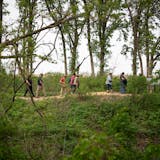Minneapolis pilot Luke Bucklin reported to air traffic control that he could not overcome wind currents pushing down his small airplane moments before it crashed in the mountains of western Wyoming, killing him and his three sons, according a preliminary federal report.
The National Transportation Safety Board (NTSB), in initial findings of the Oct. 25 crash released late Wednesday, said Bucklin radioed in that he was "unable to maintain altitude due to mountain wave activity."
The plane was at about 13,300 feet at the time of Bucklin's transmission. Bucklin's plane, a Mooney M20J, was designed to fly above altitudes that Bucklin reached that day, said Michael Huhn, the NTSB's lead investigator into this crash.
Bucklin's report of trouble with the wind was the last contact from the plane. Its disappearance set off a weeklong search, which ended with the discovery of the wreckage and the four aboard at 11,100 feet of the Wind River mountain range. Bucklin, 40, and his sons, 14-year-old twins Nate and Nick, and 12-year-old Noah, were killed on impact.
Huhn said that mountain wave activity, like what Bucklin encountered, is a "large air mass moving like a wave" that can force airplanes down in mountain areas.
The NTSB report also noted that Bucklin reported at 14,000 feet that he was encountering a "light chop" of turbulence and "a trace of rime icing" on his plane about 40 minutes after takeoff. Rime icing is granular, similar to what builds up in older models of freezers and can impact a plane's ability to gain lift when is accumulates on the wings.
Weather reports had forecast turbulence and icing along the plane's intended route, according to the NTSB. Bucklin was rated to fly under instrument guidance when visibility is poor.
Expert: Plane can't handle much ice
![Three weeks ago, Octavio Rodriguez switched from making transmission parts to casting parts for hospital bed brake assemblies at Twin City Die Castings. ] GLEN STUBBE • glen.stubbe@startribune.com Thursday, April 9, 2020 How employee-owned Twin City Die Casting, which just laid off 40 production workers of its 250 employees in what was supposed to be a good year, is trying to accelerate its pivot to growing medical parts business for ventilators, hospital beds, etc as it copes with instan](https://arc.stimg.co/startribunemedia/WNZYKGTZ5IYMUCO3KI5TR3N7WI.jpg?&w=80&ar=1:1&fit=crop)
djoles@startribune.com As boaters flock to Minnesota lakes and rivers this holiday weekend for the unofficial kick-off to the boating season, they'll face more inspections in and out of the water as local cities and counties ramp up their work to stop the spread of invasive species. Across the metro, more boat accesses will be staffed by watercraft inspectors thanks to $10 million funneled to county government programs this year, up from $4.5 million the state allocated last year. ORG XMIT: MIN1505222156290209 ORG XMIT: MIN1506021218440580](https://arc.stimg.co/startribunemedia/34QSKO44B2XKVNUZCO5SLJQSLY.jpg?&w=80&ar=1:1&fit=crop)

